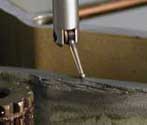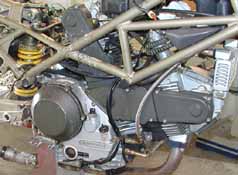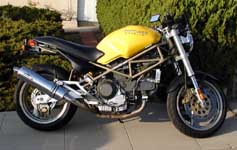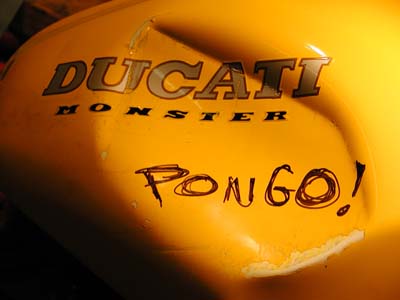
|
Meet Pongo!
Pongo! is my new Monster (as of 2002). Well, not really new, but new to me. Some guy said he's got a Monster for sale cheap on a mail list. I can't resist... and I'm in the van to the City of Angels on my latest adventure! I'm pretty excited about this salvaged and neglected bike, but couldn't come up with a name. Zina suggested Pongo. He's one of Troy Bayliss's mechanics. Definitely a name with character, so Pongo! he is! |
| Pongo came with some issues. I'll try to list them out. The tank was leaking fuel (because the locknut for the fuel level sending unit nut is cracked), right fork seal is leaking, sidestand is from a Honda (oh, the humanity), license plate rubs the tire, tail light is mounted on an angle, tires are shot, waaay dirty, battery acid has spilled about, and the bars are kinda screwed. Oh, and he had about 7 quarts of oil! I guess the sight glass was filled while on the Honda sidestand, which has extra added lean. The guy selling Pongo said he ran poorly. Well, that's certainly cause! |
| I got to looking at pongo and noticed someone had already hacked off the stock frame tubes and then welded on a "cross bar" between them. Additionally, they welded on tabs for the turn signals. Then they bent up the eyelets for the tail section and kind of wedged the tail light up in there at an angle. Real ugly. Then they mounted the license plate on one of those japanese style bent sheet metal fender mounting brackets. It was sano enough except that it put the plate into the inner fender and tire on bumps. |
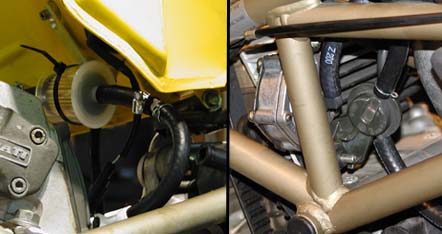 I went to Napa and spent like $40 on all sorts of goofy little stuff that I needed for Pongo.
Fuses, hoses, clamps, odd ball junk.
To recap, the fuel system has 5 components: fuel tank, fuel filter, vacuum operated fuel shut off valve, vacuum operated fuel pump, and the carburetors.
Guess what?
They all use different sized fittings.
The tank has a spigot that's between 1/4" and 5/16".
The fuel pump has a 5/16" inlet and a 1/4" outlet, with a 5/16" vacuum line fitting.
The fuel shutoff valve has 1/4" inlet and outlet, with a 3/16" or 1/8" vacuum fitting.
Oh, and the carburetors have a 5/16" inlet.
I purchased a fuel filter with 5/16" fittings in and out.
And then I added component #6: a quick disconnect fitting with valves in each part, allowing the easy removal of the tank.
I've got a small cache of these in 1/4" and 5/16" so I was able to mix and match as desired.
I ended up moving the shut off so that it lives right next to the pump (in its stock location).
To do this, I used a wellnut in place of the rubber bushing and the fixed lug at the bottom of the fuel pump, then put the mount for the shutoff between the fuel pump and the frame.
Due to a lack of 5/16" hose, I had to use and/or make a couple of step up / step down fittings for the fuel system.
Also had to use them for the vacuum system, as both vacuum operated accessories had to be converted to the size of the fittings in the manifolds.
Then I went through the carbs real quick to unclog a few jets and found a Factory Jet Kit, too.
I went to Napa and spent like $40 on all sorts of goofy little stuff that I needed for Pongo.
Fuses, hoses, clamps, odd ball junk.
To recap, the fuel system has 5 components: fuel tank, fuel filter, vacuum operated fuel shut off valve, vacuum operated fuel pump, and the carburetors.
Guess what?
They all use different sized fittings.
The tank has a spigot that's between 1/4" and 5/16".
The fuel pump has a 5/16" inlet and a 1/4" outlet, with a 5/16" vacuum line fitting.
The fuel shutoff valve has 1/4" inlet and outlet, with a 3/16" or 1/8" vacuum fitting.
Oh, and the carburetors have a 5/16" inlet.
I purchased a fuel filter with 5/16" fittings in and out.
And then I added component #6: a quick disconnect fitting with valves in each part, allowing the easy removal of the tank.
I've got a small cache of these in 1/4" and 5/16" so I was able to mix and match as desired.
I ended up moving the shut off so that it lives right next to the pump (in its stock location).
To do this, I used a wellnut in place of the rubber bushing and the fixed lug at the bottom of the fuel pump, then put the mount for the shutoff between the fuel pump and the frame.
Due to a lack of 5/16" hose, I had to use and/or make a couple of step up / step down fittings for the fuel system.
Also had to use them for the vacuum system, as both vacuum operated accessories had to be converted to the size of the fittings in the manifolds.
Then I went through the carbs real quick to unclog a few jets and found a Factory Jet Kit, too.
After sorting out the fuel system, I added oil, put on the airbox, ignition components, and the battery. Wow! The moment is here! I open the garage door, put on my ear muffs, ignition switch to on, push the button. Nothing. Huh. Ear muffs off, push start button. Click. Release start button. Click. OK, bad solenoid. So I try jumping from the (+) lead to the starter itself, but there's just not enough current to overcome the strain on the starter when the choke or throttle is opened. =( Oh, and my new fuel sending unit was leaking. Turns out it didn't come with a new gasket. Ninety facking dollars and it doesn't come with a gasket?! I drained the tank (easy to do with quick disconnects!!) and added the gasket from my old sending unit. Will test later... |
OK, the "old" gasket for the fuel level sending unit worked.
I'm pretty pleased about that.
BUT... more pleasing is that my "generic" Yamaha starter solenoid came in.
I've got inquiries in with a couple manufacturers to get the proper units, though.
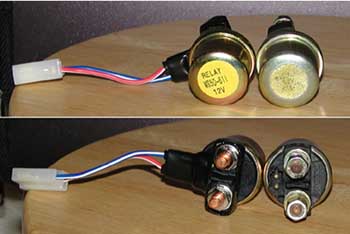 Other than the pigtail, this solenoid is absolutely identical to the OEM Ducati one, with the same manufacturer's mark on the back.
It came with a new "rubber", too.
The Yammie one has that pigtail on it instead of the leave-you-stranded-at-the-gas-station slip-fit job.
The connector has the blades perpendicular, instead of parallel.
I don't have perpendicular 2 conductor connectors in my stache, so I pulled the pins and put one of my connectors on it.
Then I cut the wiring harness on Pongo (even on a "junker" this makes me sigh) and installed the proper mate to the connector.
But I couldn't yet light off the ignition, as I had to finish putting on the airbox because the grounding strap is tied in with one of the mounts.
With that completed, I engaged the choke, powered the ignition, and held my breath as I thumbed the start button.
Pongo had the best possible start up: he simply "became running".
No catch, tumble, then run.
No.
Simply became running.
I was and am very happy for Pongo!
I left him on the choke for a goodly while to warm up thoroughly, then cut the choke and he settled into a nice idle.
I'm not even going to bother with the mercury sticks, as tickover is even and without lumps or hiccups.
Hmmm, what's that?
Oh, the charge light is on.
Tap the revs and the light goes out.
Haven't seen it since, but will allocate an RR51 for Pongo! soon.
Other than the pigtail, this solenoid is absolutely identical to the OEM Ducati one, with the same manufacturer's mark on the back.
It came with a new "rubber", too.
The Yammie one has that pigtail on it instead of the leave-you-stranded-at-the-gas-station slip-fit job.
The connector has the blades perpendicular, instead of parallel.
I don't have perpendicular 2 conductor connectors in my stache, so I pulled the pins and put one of my connectors on it.
Then I cut the wiring harness on Pongo (even on a "junker" this makes me sigh) and installed the proper mate to the connector.
But I couldn't yet light off the ignition, as I had to finish putting on the airbox because the grounding strap is tied in with one of the mounts.
With that completed, I engaged the choke, powered the ignition, and held my breath as I thumbed the start button.
Pongo had the best possible start up: he simply "became running".
No catch, tumble, then run.
No.
Simply became running.
I was and am very happy for Pongo!
I left him on the choke for a goodly while to warm up thoroughly, then cut the choke and he settled into a nice idle.
I'm not even going to bother with the mercury sticks, as tickover is even and without lumps or hiccups.
Hmmm, what's that?
Oh, the charge light is on.
Tap the revs and the light goes out.
Haven't seen it since, but will allocate an RR51 for Pongo! soon.
Evidence that Pongo! hasn't really been able to roar lately was heavy soot in the mufflers, which I was able to blow out while sitting there on the lift. Before I can get out for a pleasurable ride, there are some details to tend to... left rear turn indicator doesn't, sidestand is from a Honda, belt covers and airbox need finishing, mount up Laura's sidecovers, new chain and sprockets, and fit a new rear tire. Another huuuge project I've been working on is mounting my tire changing machine in the trailer. That was a gating factor for Pongo! as I need to mount up that freshie 180 Pilot Sport on his rear wheel. I would put on my Redracingparts rearsets, but I don't have a ready solution for the brake line and don't want to fuss with that right now. |
 Sitting on Pongo! sure made me smile!!
I think this picture was on my very first voyage with Pongo.
We had some issues to sort out since then... mostly fuel problems.
His fuel pump was shot, and he protested by leaving me stranded some 120 miles from home.
Thankfully, it was 120 miles away right off o I-8 in El Centro ... AFTER some 200 miles of back country riding!
With a new vacuum operated fuel pump, we've ridden again, but that oil leak isn't completely gone and Zina says Pongo smells bad.
Oh, and he smokes bad, too.
Soooo, sometime soon, a pair of FbF hi comp pistons are going to find their way into Pongo!
He'll get a thorough rework in his heads, too... new bearings, guides, seals, and a valve/seat regrind, too.
Sitting on Pongo! sure made me smile!!
I think this picture was on my very first voyage with Pongo.
We had some issues to sort out since then... mostly fuel problems.
His fuel pump was shot, and he protested by leaving me stranded some 120 miles from home.
Thankfully, it was 120 miles away right off o I-8 in El Centro ... AFTER some 200 miles of back country riding!
With a new vacuum operated fuel pump, we've ridden again, but that oil leak isn't completely gone and Zina says Pongo smells bad.
Oh, and he smokes bad, too.
Soooo, sometime soon, a pair of FbF hi comp pistons are going to find their way into Pongo!
He'll get a thorough rework in his heads, too... new bearings, guides, seals, and a valve/seat regrind, too.
|
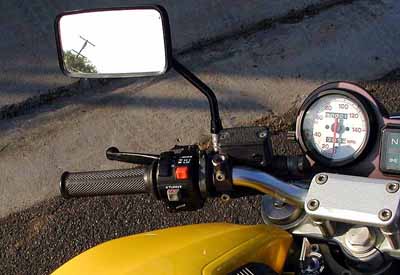 (6.2003)
Before the trip to Laguna world superbikes races in 2003, I fitted an aftermarket switch group.
I saw this in one of my vendor's catalogs and thought I'd fit it and try it out before offering it for sale to my customers.
I like being able to turn off the headlight, as Pongo's battery isn't very new and the starter acts tired.
I've got a full on switch webpage talking about doing the switch.
(6.2003)
Before the trip to Laguna world superbikes races in 2003, I fitted an aftermarket switch group.
I saw this in one of my vendor's catalogs and thought I'd fit it and try it out before offering it for sale to my customers.
I like being able to turn off the headlight, as Pongo's battery isn't very new and the starter acts tired.
I've got a full on switch webpage talking about doing the switch.
|
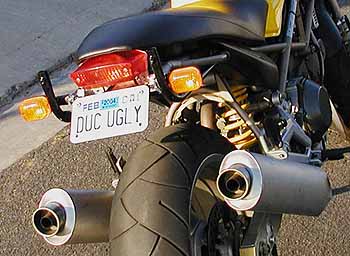 (8.3.2003) At the same time, I also installed the Ventura Pack system.
If you've got a Monster with a "chopped tail", you will definitely not be able to use the proper "carbureted Monster" L-Bracket set.
Instead, you can get the kit for the 2000 M900ie.
Once I had the wrong kit, I realized that I would be able to make the same set from Zina's bike work on mine.
I added some "KTM sytle" turn signals as they have the same appearance as OEM but mount in a more traditional wire through bolt manner.
The previous "winkers" were all but useless in the daylight.
The mods worked out well and the Ventura pack happily hauled all my trash to and from Laguna well.
Pongo also did well other than the continuous spewing forth of burned oil from the mufflers.
I've got my 11.2:1 compression JE pistons in hand and just worked out a deal to purchase some 900SS heads, so a top end rebuild should be forthwith.
(yeah right!)
(8.3.2003) At the same time, I also installed the Ventura Pack system.
If you've got a Monster with a "chopped tail", you will definitely not be able to use the proper "carbureted Monster" L-Bracket set.
Instead, you can get the kit for the 2000 M900ie.
Once I had the wrong kit, I realized that I would be able to make the same set from Zina's bike work on mine.
I added some "KTM sytle" turn signals as they have the same appearance as OEM but mount in a more traditional wire through bolt manner.
The previous "winkers" were all but useless in the daylight.
The mods worked out well and the Ventura pack happily hauled all my trash to and from Laguna well.
Pongo also did well other than the continuous spewing forth of burned oil from the mufflers.
I've got my 11.2:1 compression JE pistons in hand and just worked out a deal to purchase some 900SS heads, so a top end rebuild should be forthwith.
(yeah right!)
|
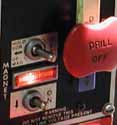 (11.2003) Next, I decided to pull the studs.
I could / should have left them be, but more than one of them were pretty rusty, so I got stupid and decided to pull the studs.
Part of the reason for wanting to change them was that I had a shipment of studs coming from APE, American Performance Engineering.
Anyway, one of the studs absolutely froze.
After twisting it (Yes, twist!), I cut it off to get purchase closer to the engine case with my stud puller.
Then it snapped just off the case.
OK, so I get more purchase... only to have it break below the case.
Click the picture to the right to read about how I performed the repair of the broken cylinder stud!
(11.2003) Next, I decided to pull the studs.
I could / should have left them be, but more than one of them were pretty rusty, so I got stupid and decided to pull the studs.
Part of the reason for wanting to change them was that I had a shipment of studs coming from APE, American Performance Engineering.
Anyway, one of the studs absolutely froze.
After twisting it (Yes, twist!), I cut it off to get purchase closer to the engine case with my stud puller.
Then it snapped just off the case.
OK, so I get more purchase... only to have it break below the case.
Click the picture to the right to read about how I performed the repair of the broken cylinder stud!
|
 (1.31.2004)
What next?
I've got plans for 3 more steps with Pongo.
1) To install dyna coils kit and then get baseline dyno run.
2) Then install the mbp ducati testarosso heads and FCR41s on short intake manifolds and get another dyno run.
Here, we look for impressive numbers.
3) Now, transfer the Testarosso heads to Pongo's original engine with the 966 kit in it and also degree in the cams.
This is the step where we're shooting for numbers previously unseen on the dyno for 2V engine.
(1.31.2004)
What next?
I've got plans for 3 more steps with Pongo.
1) To install dyna coils kit and then get baseline dyno run.
2) Then install the mbp ducati testarosso heads and FCR41s on short intake manifolds and get another dyno run.
Here, we look for impressive numbers.
3) Now, transfer the Testarosso heads to Pongo's original engine with the 966 kit in it and also degree in the cams.
This is the step where we're shooting for numbers previously unseen on the dyno for 2V engine.
|
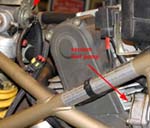
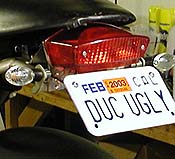
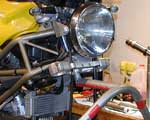

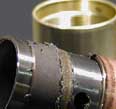
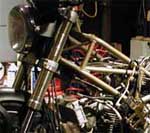
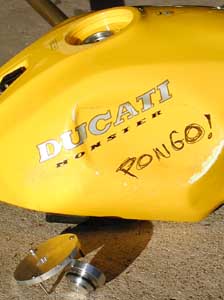 My new year's resolution was to get Pongo running on the roads - and soon.
I've been sidetracked by projects as well as leaving town three times for family matters and had let Pongo suffer on the lift.
I knew the tank was still leaking, evidenced by the smell of fuel in the garage.
Closer examination and the leak seemed to be from the tank mount.
I'd clean and dry it and the next day, it would be wet and fuel forming to drip off the lowest part of the tank.
My new year's resolution was to get Pongo running on the roads - and soon.
I've been sidetracked by projects as well as leaving town three times for family matters and had let Pongo suffer on the lift.
I knew the tank was still leaking, evidenced by the smell of fuel in the garage.
Closer examination and the leak seemed to be from the tank mount.
I'd clean and dry it and the next day, it would be wet and fuel forming to drip off the lowest part of the tank.
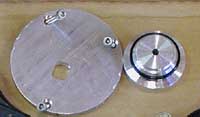
 If anyone wants to rent the plug and cover plate for leak testing or attempted dent blowing, let me know.
If anyone wants to rent the plug and cover plate for leak testing or attempted dent blowing, let me know.
